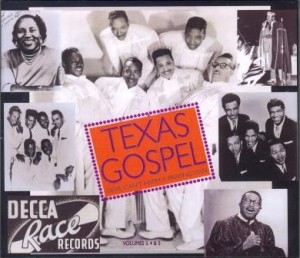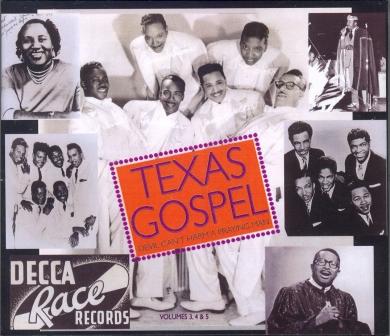
Texas Gospel, Volumes 3, 4, 5:
Devil Can’t Harm a Praying Man
Acrobat 2008
www.rootsandrhythm.com
or order via email from opalnations@yahoo.com
In the 1950s, if you were a quartet and a Peacock Recording Artist, man, you were something.
Some of the top quartets of the decade were on Peacock’s roster. Thanks to the Texas Gospel series by Opal Nations and Acrobat Records, the vast majority of Houston-based Peacock’s “World’s Greatest Spirituals” singles from its 1500 and 1700 series are now available on CD, some for the first time.
Sadly, after releasing the first two Texas Gospel volumes, Acrobat is no more. Nevertheless, gospel historian and project annotator Opal Nations has picked up the standard and is stewarding sales of Texas Gospel Volumes 3, 4, and 5. He plans for Texas Gospel to be a seven-volume series of Peacock singles when all is said and done. Meanwhile, this three-CD set, subtitled Devil Can’t Harm a Praying Man (a 1955 Dixie Hummingbirds song included here), features 85 tracks and a 60-page illustrated booklet by Nations that is so thick it hardly fits in the jewel case. (The liner notes are available for reading at www.pewburner.com/about_us.html.)
The 85 tracks on Vols. 3 – 5 take the listener from Peacock 1736 to 1781, or from 1951 to 1957, and feature quartets such as the Dixie Hummingbirds, Sensational Nightingales, Original Five Blind Boys (tracks not already included on a separate Acrobat set dedicated to the Archie Brownlee aggregation), Spirit of Memphis, Gospelaires of Dayton and singers Jessie Mae Renfro and Cleophus Robinson. Gospel hits such as the Birds’ “Trouble in My Way” and “Christian’s Automobile,” and the ‘Gales’ “Somewhere to Lay My Head” and “See How They Done My Lord” are intermixed with lesser-known but equally exquisite tracks such as the Spirit of Memphis’ “When” and the Blind Boys’ pop-flavored “There’s No Need to Cry,” featuring a passionate lead by Brownlee.
Even if you already own many of these recordings on vinyl, there is something about hearing them in chronological order. First, the experience hammers home just how much give and take there was between the “street corner” vocal groups of the mid-50s and gospel quartets when it came to employing doo-wop background vocals, impassioned leads, scooping and soaring falsetto leaps. Second, it helps you appreciate even more the artistry of the Dixie Hummingbirds and Sensational Nightingales and their respective leads Ira Tucker and Julius Cheeks. Third, hearing the various quartets in one sitting gives you a sense of the rivalry of the day, and how amazingly different the Spirit of Memphis was turning out to be. Fourth, it’s easier to carry around than a box full of 78s.
Five of Five Stars
Reviewed by Bob Marovich for The Black Gospel Blog.
2 Comments
Leave A Comment Cancel reply
Written by : Bob Marovich
Bob Marovich is a gospel music historian, author, and radio host. Founder of Journal of Gospel Music blog (formally The Black Gospel Blog) and producer of the Gospel Memories Radio Show.











 Visit Today : 10
Visit Today : 10 This Month : 92
This Month : 92
Thanks for posting information on this album! As with the previous volumes that are now out of print, this one is destined to be a hard-to-find collector’s item very soon.
One of the most intriguing aspects of this collection (for me) is having Otis Jackson’s ‘The Life Story of Madame Bethune’ from 1955, which I have been unable to find anywhere else. I have been fascinated with Mr. Jackson ever since I first heard ‘Tell Me Why You Like Roosevelt’ years ago. He had a very unique style of story-telling. Another great song he wrote was ‘Pearl Harbor’ which The Soul Stirrers performed. Are you familiar with any compilations of his work? He seems to be criminally over-looked as an artist & writer.
Thanks again for you great blog!
Hi, James — thanks for your comments. There are no compilations of Otis Jackson material as far as I know. I agree with you: as someone who presented on his life and times for ARSC in 2006, I find him to be a very interesting person. Songwriter, radio announcer, singer, promoter, recording artist. In 1985, a special tribute program was dedicated to him in Orlando, Florida.